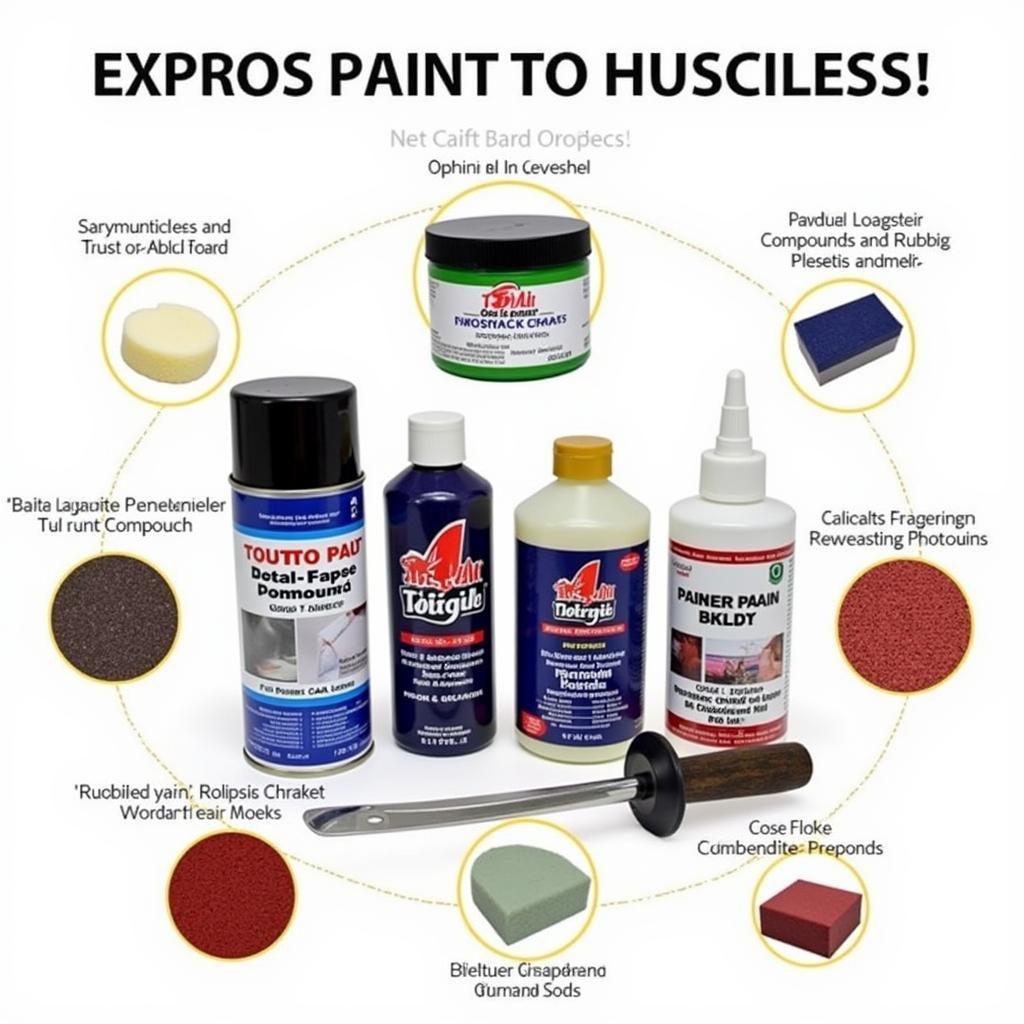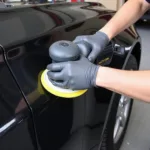Car paint repair products are essential for maintaining a vehicle’s appearance and protecting it from further damage. Choosing the right product can be daunting with the vast array available. This guide will help you navigate the world of car paint repair, ensuring you select the perfect product for your needs. Let’s dive in!
Understanding Different Types of Car Paint Repair Products
Car paint damage varies, from minor scratches to deep chips and dents. Understanding the type of damage is crucial for choosing the right repair product. For instance, a minor scratch might only require a polishing compound, while a deep chip necessitates a touch-up paint and clear coat.
Repairing Minor Scratches and Swirls
Minor scratches and swirls can often be addressed with a polishing compound or a scratch remover. These products work by abrading a very thin layer of the clear coat, leveling out the imperfections and restoring the paint’s shine. Check out products specifically designed for waxing after paint repair product to repair car paint for waxing.
Addressing Paint Chips and Deeper Damage
Deeper damage like paint chips requires a more involved approach. Touch-up paint kits designed for specific car models are ideal. These kits typically contain the base coat, clear coat, and application tools. For chip repairs, consider specialized products. See more on car paint chip repair products.
Removing Rust and Preventing Future Corrosion
If rust is present, a rust remover is necessary before applying any paint repair products. This ensures a clean surface for the new paint to adhere to, preventing further corrosion. Primer application after rust removal is also essential to protect the bare metal and provide a suitable base for the paint.
Factors to Consider When Choosing Car Paint Repair Products
Several factors influence the choice of car paint repair products. Knowing your car’s paint code is essential for precise color matching when using touch-up paint. The severity of the damage dictates the type of product required, and your budget will determine which options are feasible. You might also consider products for swirl removal, such as those found at car paint swirl repair.
Matching Your Car’s Paint Code
Accurately matching your car’s paint code is crucial for seamless repairs. This code can usually be found on a sticker inside the driver’s side doorjamb or in the owner’s manual. Using the correct paint code guarantees a perfect color match and prevents a mismatched spot on your car’s finish. If you are repairing scratches and need a polish, check out car polish paint scratch repair shopify.
Assessing the Severity of the Damage
The extent of the damage directly influences the type of product required. A minor scratch can be buffed out, while a deep chip or dent necessitates filling, sanding, and repainting. Properly assessing the damage prevents unnecessary work and ensures the right repair method is employed. Products like car paint repair kits can be particularly useful. See some examples at car paint repair kit uk.
 Different types of car paint repair products displayed on a workbench
Different types of car paint repair products displayed on a workbench
Conclusion
Choosing the right car paint repair products involves understanding the type and severity of the damage, your car’s paint code, and your budget. By carefully considering these factors, you can effectively restore your car’s finish and protect it from future damage. Remember to follow the manufacturer’s instructions for best results.
FAQs
-
What is the best car paint repair product for scratches? This depends on the severity of the scratch. Light scratches might only need a polish, while deeper ones may require a scratch remover.
-
How do I find my car’s paint code? Your car’s paint code is usually located on a sticker inside the driver’s side doorjamb or in the owner’s manual.
-
Can I repair rust myself? Yes, minor rust can often be repaired with a rust remover and touch-up paint. However, extensive rust may require professional attention.
-
How do I prevent future rust? Regularly washing and waxing your car can help protect the paint and prevent rust.
-
What is the difference between a polishing compound and a rubbing compound? A rubbing compound is more abrasive than a polishing compound and is used for removing deeper scratches and imperfections.
-
How do I apply touch-up paint? Clean the area, apply the touch-up paint in thin layers, allowing each layer to dry before applying the next.
-
When should I seek professional car paint repair? For extensive damage, such as deep dents or large areas of rust, it is best to consult a professional.
Situations that often raise questions about car paint repair products
-
Noticing a scratch after a car wash: Often the car wash itself isn’t the culprit, but rather it reveals pre-existing scratches that were previously less visible. This can lead to questions about which repair product is best for this type of scratch.
-
Finding a chip in your car’s paint: This situation necessitates choosing a touch-up paint that perfectly matches the car’s original color, leading to questions about finding the correct paint code and application techniques.
-
Discovering rust on your car: This calls for products that not only address the cosmetic issue but also prevent further corrosion. Questions often arise about rust removers, primers, and preventing future rust formation.
Other helpful articles on CarRepairOnline:
- Learn more about fixing paint chips on your car.
- Discover the best ways to remove swirls from your car’s paint.
- Find the right product to repair your car’s paint before waxing.
Need assistance?
Contact us via WhatsApp: +1(641)206-8880 or Email: [email protected]. Our customer service team is available 24/7.


